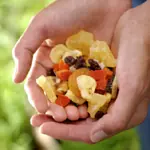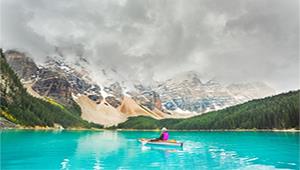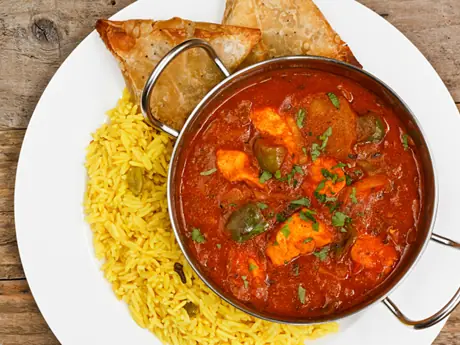
The longer the trip, the more obsessive my preparation. I am second-guessing my experience, sounding out new ideas, scratching at lists ad nauseam, and generally neglecting the care and feeding of my spouse and myself.
Shopping for the Basics
I practice a pretty consistent diet whether I'm at home or on the road, so shopping for camping trips is easy. I use the same ingredients and methods; one is just a backpackable version of the other. This way preparing for--and cooking in--the backcountry and at home becomes less time consuming and more affordable.At home I stock gallons of oil and tamari, and pounds of oats and nuts. When shopping for a trip I take an artillery of Nalgene bottles and plastic freezer bags, and write the weight of each item as I fill each bag from the bulk food tins.
Think Multicultural
Here are some timeless standard ingredients I keep at home which are perfect for kitchens aground or afloat, or anywhere (like your backpack) space is at a premium.Annie's Pantry
- Chilies. Dried chili peppers of varying heat are indispensable. Add a few teaspoons of chili flakes to your spice kit.
- Cooking oil. I always purchase oil in bulk then fill smaller bottles to suit the length of the trip. For this two-week backpacking trip to Alaska, I rationed about two tablespoons of olive oil per person per day, which is conservative but still weighs in at two pounds.
- Curry. India's signature blend of herbs and spices belongs in every backcountry kitchen. Powder is convenient, but a tablespoon of paste packed in foil with some shredded coconut is darned authentic tasting.
- Dried fruit. Apples, apricots and prunes are available in bulk and not worth drying yourself. The best foods to dry are fresh-picked strawberries, or fragrant nectarines in peak season.
- Ginger. Like garlic, fresh ginger is easy to carry, long-lasting, and hugely versatile. One lumpy, homely root adds zip to stir-fry and sauces, and will also absorb powerful odors of other ingredients, like fish and some seaweeds. Additionally, ginger is a traditional folk remedy for all sorts of digestive ills, including upset stomach, constipation and congestion. When you're really cold, a few slices boiled in water will perk you right up. Crystallized ginger is also a great appetite suppressant and breath cleanser on hikes.
- Grains. Think beyond rice and pasta. Try quick-cooking whole grains like bulgur wheat, oats, cornmeal, barley, and precooked/dried wild rice. You'll add variety and more efficient trailside nutrition--whole grains offer more calories per serving than refined versions.
- Legumes. We're talking beans here--lentils, soybeans, pintos, whatever. Serve them with nuts, seeds, or grain, and you have a complete protein. Presoak, cook, and dry your own at home for an instant soup base that's super econimical.
- Miso. An ideal protein for many vegetarians, pleasantly salty miso is also low in fat, adds a depth of flavor to curries, stews, grains and potatoes, and keeps your intestinal flora healthy (take note, water-wary backcountry or third-world travelers). Miso keeps infinitely in the fridge, and I've never known it to spoil, even on extended adventures.
- Nuts. From muesli to gorp to peanut butter, nearly every camp kitchen features nuts in some form. Compact and caloric, nuts are a space- and weight-efficient addition to your pack. However, nuts must be chewed well in order to gain the nutrients, and take longer to digest than most other backpacking foods. Look to them for flavor and texture, not a primary source of calories.
- Seeds. Think of seeds as vegetable eggs, with all the nutrients necessary for growth. Lightweight, compact, and rugged, seeds provide protein, iron, calcium, fat, and an array of vitamins. Pumpkin, sunflower, and sesame seeds are excellent staples.
- Sesame. Fifty percent of this iron and vitamin packed staple seed is unsaturated fat. Try a few drops of chili-infused sesame oil in a peanut butter sandy. Sesame takes many forms: oil, tahini, halvah, gomasio, or bulk seeds.
- Tamari. Nutritionally superior to common commercial soy sauce, tamari is chem-, wheat-, and sugar-free. Use sparingly late in the cooking process or as a salt substitute.
- Vinegar. Pack a tiny bottle of rice or wine vinegar for adding to rice and grain dishes, greens, and foraged salad.
- Wasabi. This pale-green Japanese horseradish is sold as a powder. Its potent bite can disguise the most disgusting slime you ever have to swallow. Look for handy foil envelopes and use in place of mustard.
Recipes for the Road
Thanksgiving Seed MixThis intriguing mix is delicious as a snack or garnish. Expect pilfering from your tentmates.
- Pepitos
- Salted corn nuts
- Pine nuts
- Dried cranberries
- Roasted sunflower seeds
Quick Cashew Dip
- 1/2 cup cashew pieces
- 1 tablespoon arrowroot
- 1/2 teaspoon salt
- 2 tablespoons dried parsley
- 1 tablespoon ground ginger
- pinch of lemon peel
Outdoor writer Annie Getchell cut her climbing teeth in the Cascade Range of Oregon and Washington, a classic training ground for all-around mountaineering. Then she met her match: A man with all the same kinds of alpine footgear. She soon found herself cragging around New England's granite, where she took her first lead falls. For the past 12 years she's enjoyed peak bagging; aid climbing desert sandstone walls; summiting granite towers in Canada; hangdogging in Sardinia, and (reluctantly) ice climbing Quebecois waterfalls. "All the different forms combine to make me feel secure in the mountains and sure of my judgment--I know when I am afraid," she says.









Discuss This Article